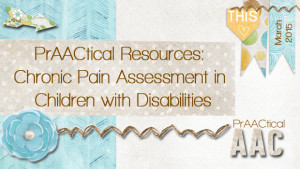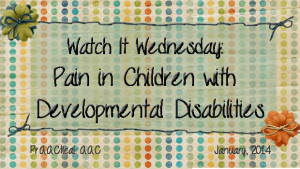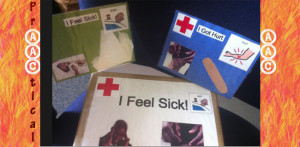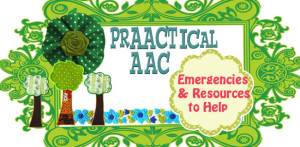Tag Archive: pain
May 24, 2020
by Carole Zangari -

Happy Sunday, AAC friends. We have some posts for you to check out. Monday – PrAACtical Resources: Assessing Distress in Individuals with Communication Challenges Tuesday – AAC Link Up Wednesday – Video of the Week: Tech Tips for Modeling in Tele-AAC Activities Thursday – Growing AAC Professionals: When Learning Meets Service ::::::::::::::::::::::::::::::::::::::::::::::::::::::::::::::::::::::::::::::::::::::::::::::::::::::::::::::: Have a little more time? These might be of interest. Five Places for Shared AAC Materials Five AAC and Related Resources to Explore AAC Teamwork: Encouraging Colleagues #1 (downloadable) AAC Teamwork: Encouraging Colleagues #2 (downloadable) AAC Teamwork: Encouraging Colleagues #3 (downloadable) AAC: More Teaching, Less Testing (downloadable)
Filed under: Featured Posts, PrAACtical Thinking
Tagged With: pain, teaming, telepractice
May 18, 2020
by Carole Zangari -

The use of pain scales is common in healthcare settings to help identify and monitor levels of discomfort. To better address the needs of individuals with significant communication difficulties, Northgate Hospital in the UK created a more detailed tool that expands this concept. Today, we look at the Disability Distress Assessment Tool (DisDAT) which identifies distress and things that signal that for a specific individual with a communication difficulty. DisDAT helps to identify the ways that a specific individual with complex communication needs shows signs of distress and discomfort. You can explore the DisDAT and learn more about how to use it here. There is also a form for monitoring these signals over time (click here for download). Many thanks to the team at Northgate Hospital for creating these tools and making them freely accessible. :::::::::::::::::::::::::::::::::::::::::::::::::::::::::::::: Regnard, C., Reynolds, J., Watson, B., Matthews, D., Gibson, L, & Clarke, C.... [Read More...]
Filed under: Featured Posts, PrAACtical Thinking
Tagged With: discomfort, DisDAT, pain
March 24, 2015
by Carole Zangari -

You don’t have to do AAC work for very long before you become acutely aware that many of our prAACtical friends experience chronic pain. We can all relate to the ways in which pain impacts a person’s behavior and participation in life experiences. Even very low-level pain can be terribly distracting, highly annoying, and cause us to have difficulty concentrating. From GERD to muscle spasms to constipation, children with AAC needs often experience pain that goes undetected or inadequately treated. In today’s post we look at some resources for assessing pain in children with disabilities. Thanks to Holland Bloorview Kids Rehabilitation Hospital for these fine resources. You can access their resources here and watch a brief video on pain in children with cerebral palsy here.
Filed under: PrAACtical Thinking
Tagged With: family, pain, resources
January 8, 2014
by Carole Zangari -

Frustration. Fear. Helplessness. Being with a child in pain is an awful experience no matter what the circumstances. When a child has communication difficulties, the problems are magnified. In this video, we go to the Canadian Association of Paediatric Health Centres for an informative discussion about pain in children with developmental disabilities. Knowing what to look for is a first step in helping reduce pain and increase the coping skills of children with AAC needs. Direct Link to Video: https://www.youtube.com/watch?v=l-CzjHl1aqo
Filed under: PrAACtical Thinking
Tagged With: Medical, pain
September 15, 2012
by Robin Parker -

We were looking over the great hospital resources from Patient Provider Communication Forum, Central Coast Children’s Foundation, Dr. Bronwyn Hemsley, and Widgit Software that Carole wrote about and realized that not everyone automatically knows how to talk about pain, illness and injury. We often need to teach the expression of these concepts. We use various types of modeling and create Boxes or Drawers that have items (i.e., bandaids, antiseptic, washcloth, ice buddy, etc) to ‘help with Cuts/Scrapes’ (or any other illness). We have had some fun and lots of practice using these apps to also help the learning process. 5 Apps To Learn and Practice Talking About Pain, Illness, & Injury Don’t forget to model, play, and use the apps often in the teaching process so when they are really needed you will see spontaneous communication and language. Toca Doctor– learning about injury and sickness through fun noncompetitive challenges that involve ‘healing’ the damaged part.... [Read More...]
Filed under: PrAACtical Thinking
Tagged With: Apps, illness, Injury, Medical Resources, pain, visual supports
March 19, 2012
by Robin Parker -

It has been a really long weekend. A very close relative had a significant medical emergency this week. The emergency involved intubation, an air ambulance (that is helicopter), and many many procedures. With the intubation, there was a temporary loss of speech which made communication difficult to say the least. This was a time that the patient (my relative) needed communication most, yet there were multiple barriers to effective communication (no speech sounds, tubes in the mouth obscuring lip movement, noise, etc..). Although the hospital staff was amazingly wonderful, communication was not their priority. Lucky, for us, I just happened to have some AAC apps on my iPhone. At one point, the AAC app was literally a lifesaver (thanks so much to Verbally for providing an easy way to communicate complex questions, reminders, and comments). As I was waiting around for many hours, texting Carole, we started thinking about... [Read More...]
Filed under: PrAACtical Thinking
Tagged With: change of schedule, distress, emergencies, Emergency, hospital, illness, Medical, pain, resources, visual supports





